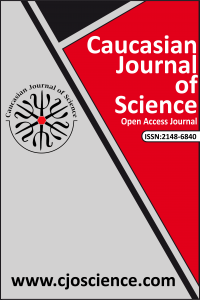EXPERIMENTAL (FT-IR, NMR) AND THEORETICAL (B3PW91, B3LYP, HF) ANALYSES OF 2-(3-ETHYL-4,5-DIHYDRO-1H-1,2,4-TRIAZOL-5-ON-4-YL)-AZOMETHINE)-BENZOIC ACID
EXPERIMENTAL (FT-IR, NMR) AND THEORETICAL (B3PW91, B3LYP, HF) ANALYSES OF 2-(3-ETHYL-4,5-DIHYDRO-1H-1,2,4-TRIAZOL-5-ON-4-YL)-AZOMETHINE)-BENZOIC ACID
2-(3-Ethyl-4,5-dihydro-1H-1,2,4-triazol-5-on-4-yl)-azomethine)-benzoic acid has been optimized using DFT(B3PW91, B3LYP)/HF methods and 6-311G++(d,p) basis sets. Then, 13C-NMR and 1H-NMR spectral values according to GIAO method were calculated using Gaussian G09W program package in gas phase and in DMSO solvent. Theoretical and experimental values were plotted according to δ exp=a+b. d calc. Theoretical spectral values of molecule were calculated and compared with experimental values. The veda4f program was used in defining FT-IR data. The standard error values were found via the Sigma plot with regression coefficient of a and b constants. The vibrational frequency values of this molecule have been calculated by using 6-311G++(d,p) basis set with DFT(B3PW91,B3LYP) and HF methods. Then, these values are multiplied with scala factors. IR spectrums were drawn with obtained values according to HF and DFT method. In addition, the molecular surfaces such as the electron spin potantial (ESP), the molecular electrostatic potential (MEP), the total density, the electron density, the electrostatic potential of the molecule were designated. Also, electronegativity (χ), global hardness (η), softness (σ), electron affinity (A) and ionization potential (I), highest occupied molecular orbital-lowest unoccupied molecular orbital (HOMO-LUMO) energy, ELUMO-EHOMO energy gap (ΔEg), the thermodynamics properties (entropy S0, heat capacity CV0 and enthalpy H0), bond angles, bond lengths, mulliken atomic charges, total energy, dipole moments, were calculated with Gaussian 09W program on the computer.
___
- Asiri A.M & Khan S.A. (2013). J. Photochem Photobiol B, 120, 82.
- Aydogan F., Ocal N., Turgut Z., Yolacan C. (2001). Transformations of aldimines derived from pyrrole-2-carboxaldehyde. Synthesis of thiazolidino-fused compounds, Bull. Korean Chem. Soc 22 (5), 476-480.
- Azam F., Singh S., Khokhra S.L., Prakash O. (2007). Synthesis of Schiff bases of naphtha [1, 2d] thiazol-2-amine and metal complexes of 2-(20-hydroxy) benzylideneaminonaphthothiazole as potential antimicrobial agents, J. Zhejiang Univ. Sci. B 8 (6), 446-452.
- Dash B., Mahapatra P.K., Panda D., Patnaik J.M. (1984). J. Indian Chem.Soc., 61, 1061.
- Frisch M.J., Trucks G.W., Schlegel H.B., Scuseria G.E., Robb M.A., Mennucci B., Petersson G.A., Nakatsuji H., Caricato M., Li X. et al. (2009). Gaussian 09, Revision C.01, Gaussian, Inc., Wallingford, CT.
- Fukui K., Yonezawa T., Shingu H.J. (1952). A molecular orbital theory of reactivity in aromatic hydrocarbons, J. Chem. Phys. 20, 722-725.
- GaussView 5.0, Gaussian, Inc., Wallingford CT, (2009).
- Jamróz M.H. (2004). Vibrational Energy Distribution Analysis: VEDA 4 program, Warsaw.
- Ma D-Y., Zhang L-Y., Wu T-L., Li D-H., Xie X-Q., Guo H-F., Qin L. (2016). J. Coord Chem, 66,3261.
- Merrick J.P., Moran D., Radom L. (2007). An Evaluation of Harmonic Vibrational Frequency Scale Factors. Journal of Physical Chemistry, 111(45), 11683-11700.
- Mulliken RS. (1955). Electronic Population Analysis on LCAO–MO Molecular Wave Functions I. J. Chem Phys. 23, 1833–1840.
- Nair R., Shah A., Baluja S. (2006). J. Serb Chem, 71, 733.
- Ocak N., Çoruh U., Kahveci B., Şaşmaz S., Vazquez-Lopez EM., Erdönmez A. (2003). 1- Acetyl-3-(p-chlorobenzyl)-4-(p- chlorobenzylidenamino)- 4,5-dihydro-1H-1, 2, 4- triazol-5-one. Acta Cryst. Sec. E. 59(6), 750-752.
- Puchtler S. (1981). Meloan, On schiff's bases and aldehyde-Fuchsin: a review from H. Schiff to RD Lillie, Histochem. Cell Biol. 72 (3) 321-332.
- Ustabas R., Çoruh U., Sancak K., Ünver Y., Vazquez-Lopez EM. (2007). 1-(benzoylmethyl)-4-[(2,4-dichlorobenzylidene)amino]-3-(2- thienylmethyl)4,5-dihydro-1H-1,2,4-triazol-5-one. Acta Cryst. Sec. E.63, 2982- 3051.
- Wang M.,Wang L.F., Li Y.Z., Li Q.X., Xu Z.D., Qu D.M. (2001). Trans Met. Chem, 26, 307.
- Wolinski K. Hilton J.F. and Pulay P.J. Am. Chem. Soc., (1990). 112, 512.
- Xia Z.P., Wang X.D., Wang P.F., Zhou Y., Zhang J.W., Zhang L., Zhou J., Zhou S.S., Ouyang H., Lin X.Y., Mustapa M., Reyinbaike A., Zhu H.L. (2014). Eur. J. Med. Chem., 80, 92-100.
- Yadav L.D.S., Singh S. (2001). Indian J. Chem., 40 B, 440.
- Yüksek H., Akdeniz F., Bahçeci Ş. (2006). Bazı Potansiyel biyolojik aktif 4,5-dihidro-1H-1,2,4-triazol-5-on Türevlerinin Sentezi ve Yapılarının Aydınlatılması. Kimya 2006, XX. Ulusal Kimya Kongresi, Kayseri, Bildiri Özetleri Kitabı, OKS-03.
- Yayın Aralığı: Yılda 2 Sayı
- Başlangıç: 2014
- Yayıncı: Kafkas Üniversitesi
